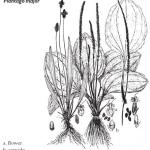Broadleaf Plantain in Lawns
Common Name: Broadleaf Plantain
Botanical Name: Plantago major L.
Other Names: White man's footprint, dooryard plantain, common plantain
Distribution
Broadleaf plantain is found throughout the United States and southern Canada.
Life Cycle
Broadleaf plantain is a broadleaf perennial. It reproduces by seeds which are formed in late summer. Seedlings emerge in late spring through midsummer, and occasionally in the fall.
Habitat
Broadleaf plantain is primarily a turfgrass weed. It grows best in nutrient rich moist soils, but tolerates heavily compacted soils, wet soils, and dry soils.
Description
Broadleaf plantain forms a rosette of leaves with parallel venation. The leaves form on long broad petioles and may grow up to six inches long and three to four inches across when left unmown. The leaves are often waxy, blue-green and may be wavy. The roots are fibrous and arise from a short fleshy taproot. The inconspicous flowers are produced on long leafless flower stalks arising from the rosette. The seeds are formed in small capsules along the length of the flower stalk, and are dark brown, glossy and minute.
Cultural Management
Broadleaf plantain spreads by seed so elimination of flowering plaintain before seed dispersal will deter spread. However, broadleaf plantain tolerates close mowing well and mowing alone will not prevent seed dispersal. The plants can be hand weeded but the short tap root must be dug out to prevent regrowth.
Broadleaf plantain tolerates compacted soils, moist or dry conditions, as well as moderate shade to full sun. Heavy infestations may indicate shady, compacted, moist soil conditions. Moist, compacted soils should be aerated and drainage should be improved to deter reinfestation. Maintaining a dense vigorous lawn will deter spread.
Management with Herbicides
Broadleaf plantain can be chemically controlled with several products, including two- and three-way combinations of broadleaf herbicides. The best control can be achieved when broadleaf plaintain is actively growing, especially during spring and fall. The turfgrass area should not be mowed for two to three days before and after herbicide application. The treatment application should be done at a time when there is no rainfall expected for at least 12 hours.
